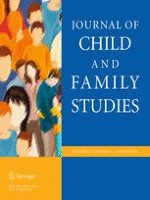24-05-2015 | Original Paper
Longitudinal Analysis of the Role of Family Functioning in Substance Use
Gepubliceerd in: Journal of Child and Family Studies | Uitgave 1/2016
Log in om toegang te krijgenAbstract
Substance use during adolescence and emerging adulthood is a risk factor for subsequent substance abuse, and it may be related to emotional and behavioral problems. Research shows the importance of family relationships in preventing substance use. However, much of the research in this field comes from large cross-sectional and epidemiological studies, and there is a lack of longitudinal studies that analyze both the intra-individual change and the protection factors associated to it. Using HLM analysis, the present longitudinal study found a linear increase of substance use throughout adolescence and emerging adulthood. We found no differences in early adolescence between sexes, but boys increased substance use more than girls throughout adolescence. Moreover, adolescents who remembered caring mothers during childhood reported less substance use during early adolescence, and those with more cohesive families showed less increase in substance use during adolescence and emerging adulthood. Finally, we discuss the importance of family care and family cohesion on preventing substance use during adolescence and emerging adulthood.
